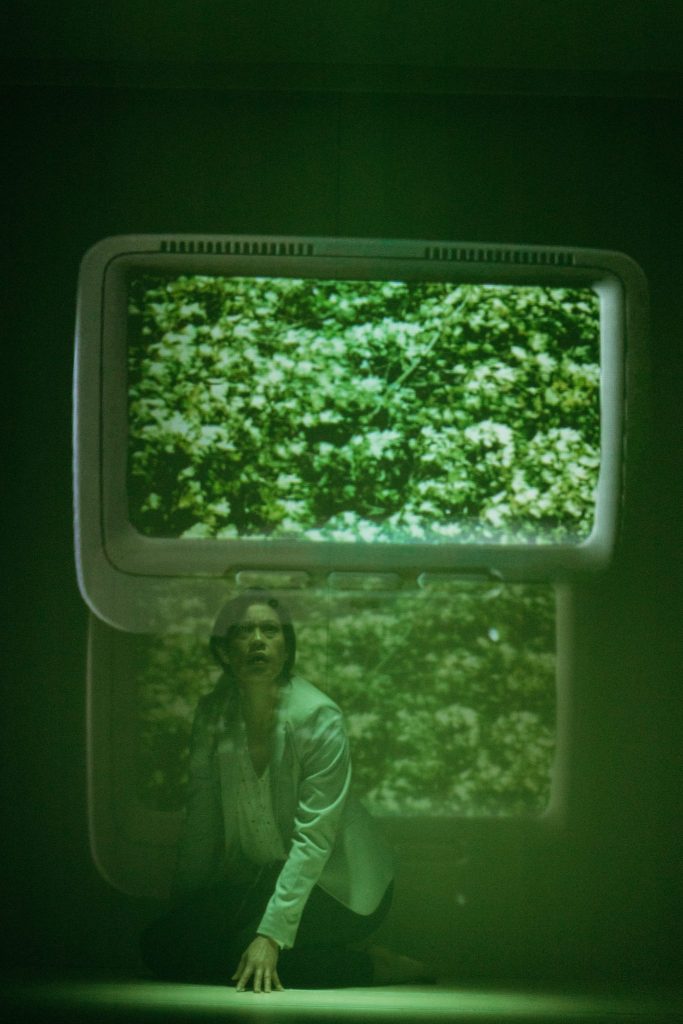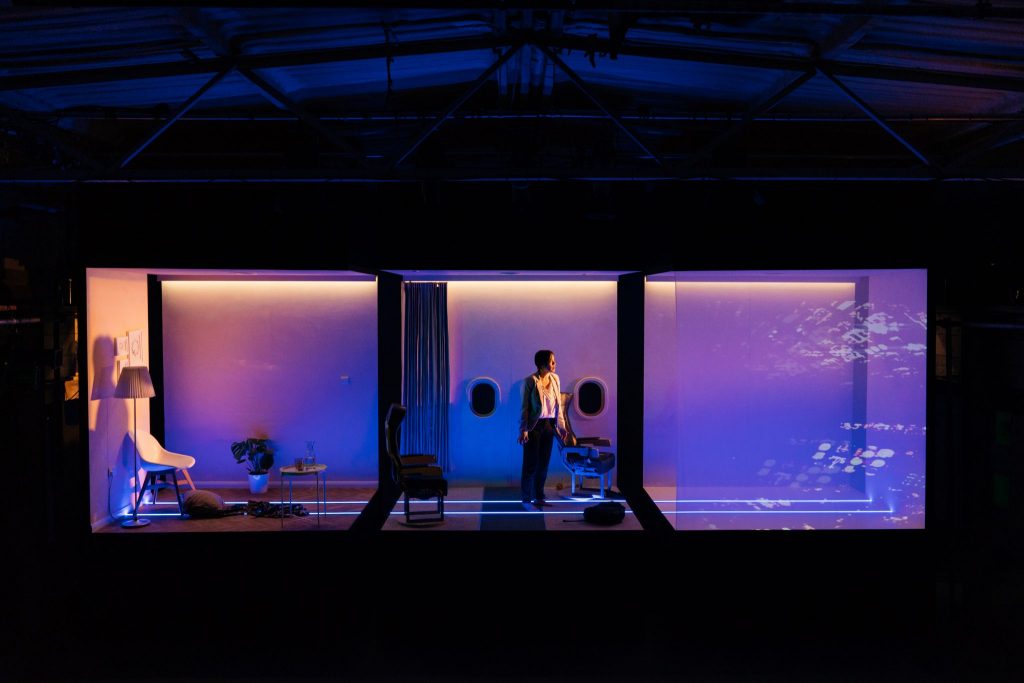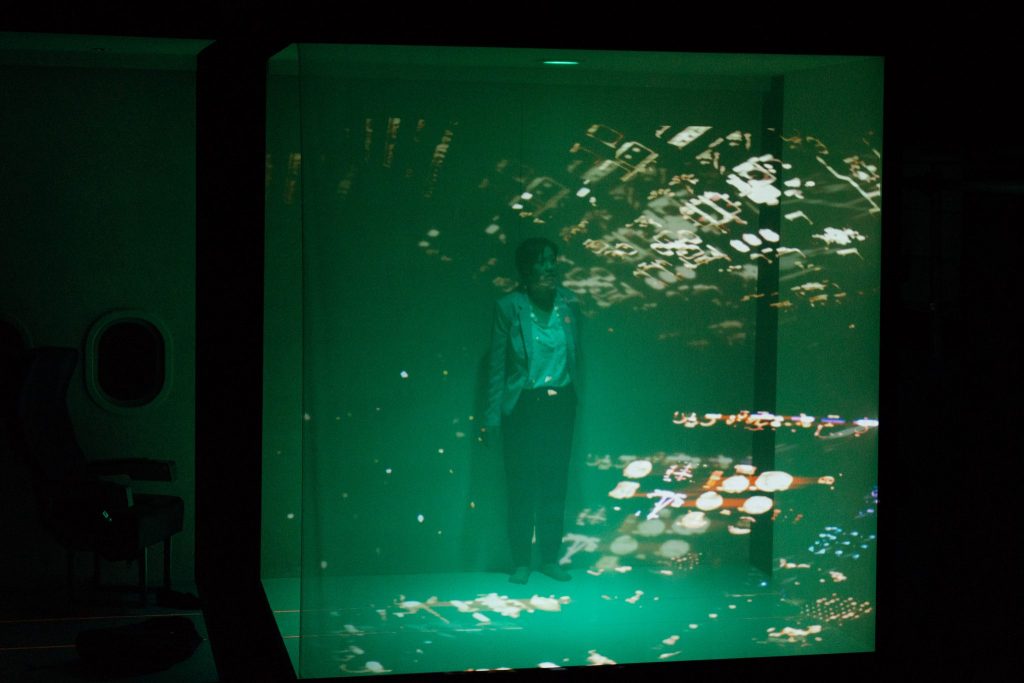Last night took Pawn to the latest at The Yard theatre, A Kettle of Fish, by Brad Birch, performed by Wendy Kweh and featuring a rich soundscape by Max Pappenheim. It was an immersive treat, to be sure.
The set (above) is simple, a linear space divided into thirds: lounge, cabin and cube. The former serves as a space grounded in reality, the middle, a space in motion — train car or airplane cabin, the latter is dream, or fear, somewhere within the mind. The mind of Lisa, that is, played expertly by Ms Kweh. Lisa is a single woman, recently looking after her newly widowed father, and working a high-stress job. This job is taking her on a business trip, and that trip makes up the meat of this show.

Photo by Helen Murray
The set is a wonder of simplicity, and serves its purposes well. Designed by Ingrid Hu, lit by Joshua Gadsby, it provides a pallet upon which Kweh can move from place to place, mood to mood, with just a step or two. Projections by Tegid Cartwright play upon a scrim draped across the face of the cube, stage left, and, through that, upon the wall behind it. Within this cube Lisa may wander within her mind’s eye, or be cast into harsh reality, by Cartwright’s deft control of the visual mood. All under the direction of Caitlin McLeod, this team of designers have taken the spare and small stage of The Yard and within it take us from Lisa’s house to the train station, the train itself, airport, plane. All along the way we are surrounded by Pappenheim’s soundscape, inescapable due to the wireless headphones each of us wear.
Pawn is no stranger to immersive productions (a term often abused in its vagueness, but quite appropriate here) nor are wireless headphones a novelty, having been used to great effect by Silent Opera in their La Bohème some years back. (interesting side note, these headphones were branded with a logo for “Silent Disco”). Whereas Silent Opera’s use was to pipe in the music of a recorded orchestra (and reinforce vocals), in this case it is a panoply of music, sound effects, aural nudges. And Lisa’s voice, sometimes her live voice, as she addresses either the audience (a common feint) or her unseen characters, or send us her (normally unspoken) thoughts. It is this last use which most sets this apart from your typical single handed production, as Lisa serves as her own Greek chorus at times.
I’ll come right out and say it; the design team, as a whole, deserve whatever award can be given for this sort of work. The whole of it is so brilliantly executed that it easily overcomes the limitations intrinsic in so small and under equipped a space as Yard. For being a one hander, this feels more like a fine ensemble production, the tech is so intimately woven into the work Kweh makes on stage.
The production, then, is as good as can be. The script, however, could use some work. Before picking nits, however, let me say that I left the theatre happy, thrilled, and moved. One cannot ask for much more. That said, there are times when we audience members feel as unteathered as Lisa appears to.
The story (no spoilers) starts with some plain exposition. We meet Lisa, learn of her contentious relationship with her father, and of her stressful work life. As the story progresses, through her commute to the airport, she lets us in on some truths about her job, her employer, and her sidelines. She is involved with the data side of PR, the polling and data mining which go into understanding a market, whether it’s customers or business partners. She shares that she’s heavily active on social media, maintaining numerous false identities so as to insinuate herself into fora and discussions that her real identity would preclude. The people with whom she works are, to her, schemers and climbers and otherwise incompetent. But Lisa is junior, and so must appease.
Shortly after the flight begins, a flight attendant taps Lisa on the shoulder, takes her aside, and tells her something dreadful is happening on the ground. Lisa’s life is upended, but she’s trapped on this plane, 30,000 feet in the air, and can do nothing about it. What ensues, as Lisa tries in vain to phone down to Earth, is a fugue state anxiety attack. Lisa drifts in and out of her present reality, ruminates on her firm and its plans, experiences flash-backs to happier times, sees in her fellow passengers the faces she has stolen, online, as avatars for her false identities. All of this is happening as the plane hurtles towards a former East Bloc nation to which her firm will be relocating. Or will it? All depends on Lisa and her persuasive powers and data-mined factoids.
That’s all I’ll tell you of the story, but of my complaints let me say this; the orthogonal narrative forays sometimes seem too highly contrived, and, at times, wholly disconnected. One wonders if the piece were edited by a non-English speaker? But, and this is significant, I cannot say if this ultimately detracts from the theatre going experience. Odd as it might sound, this sort of disconnectedness, detachment, as it were, from the narrative train, might just be working, under the psychological hood, to bring us all along with Lisa on this hellish ride of hers.
You have until 13 October to find out for yourself. Tickets still available, and in this intimate space, all seats are good.


